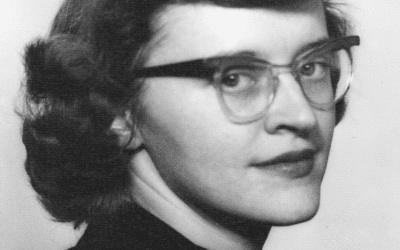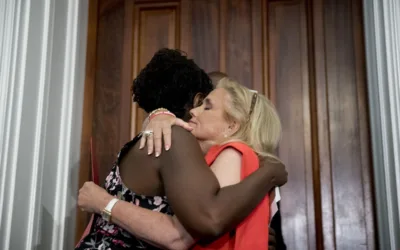
EAST LANSING, MI - NOVEMBER 08: A worker helps a voter at a polling location on the Michigan State University campus on Election Day on November 8, 2022 in East Lansing, Michigan. After months of candidates campaigning, Americans are voting in the midterm elections to decide close races across the nation. (Photo by Bill Pugliano/Getty Images)
Many experts predicted chaos on Election Day. That didn’t happen in Michigan.
DETROIT—Once the site of furious Trump supporters banging on windows and demanding that election workers “stop the count,” Huntington Place in Detroit was drama-free on Tuesday, as election workers tallied absentee ballots in peace.
“It’s been very business-like here,” said Matt Friedman, a spokesperson for Detroit Votes 2022, a nonpartisan voter engagement program launched earlier this year by the city of Detroit.
Friedman was managing media relations in the ballot counting room, where election workers thumbed through envelopes under the watchful eyes of polite observers. It was quiet and straightforward, more like a classic Michigan assembly line than something suitable for cable news.

The scene at Huntington Place was an example of what happened everywhere in Michigan on Election Day: Voting the way it used to be, before the presidency of Donald Trump and the chaos of the 2020 election. After much anticipation, Nov. 8 came and went far more smoothly than what many experts had predicted, even with record turnout across the state.

Why We Worried
In the weeks leading up to the election, reports warned of far-right extremists recruiting and training record numbers of poll watchers and election challengers. Combined with a nationwide shortage of poll workers, and a plea from Michigan’s clerks for more resources, concerns over election disruptions were high in this swing state.
Anyone thinking back to the political chaos in Michigan just two years ago would have been justified in worrying about Tuesday’s election. In April 2020, not long after the start of the COVID-19 pandemic, an armed mob angry with the state’s health and safety restrictions stormed the Capitol building in Lansing.

In October 2020, 13 men were arrested for plotting to kidnap Gov. Gretchen Whitmer and overthrow Michigan’s government. In November 2020, a group of fake electors conspired to hide overnight in the Capitol to certify the presidential election for Donald Trump.
Remember: Chaos Hits Traverse City After Commissioner Flashes Gun During County Meeting
And two years later, conservative extremists were still threatening the democratic process. Before the state’s August primary, Ryan Kelley—a Republican candidate for governor, who was charged with four misdemeanors following his participation in the Jan. 6 insurrection—instructed poll workers to unplug voting equipment as a way to root out potential fraud. (Tampering with voting equipment is a federal offense.) Then, GOP leaders in Wayne County were caught instructing election workers and watchers to sneak cell phones into polling places. Then, clerks in Macomb County and near Grand Rapids hired election deniers (one a Jan. 6 participant, and one charged with falsifying election records) to work the primaries. Then, the Republican candidate for attorney general was placed under investigation for an alleged plot to seize and tamper with voting machines. That investigation is currently ongoing.
But what was especially concerning was the sheer number of election deniers on the ballot—among them, the three GOP candidates at the top of the ticket, none of whom said they’d accept election results should they lose.
Sign of the Times: Booby-Trapped ‘Trump 2020’ Sign Sends Oakland County Worker to Hospital
Indeed, it was one of those candidates who made an alarming last-gasp challenge to election integrity. Two weeks before the midterms, Kristina Karamo—the Republican nominee for secretary of state—filed a lawsuit seeking to stop the inclusion of Detroit’s absentee ballots in the official vote count, to prevent Detroit residents from voting early in person, and to expand election observers’ access to Detroit’s absentee ballots.
On Monday, Nov. 7—the day before the election—Wayne County Circuit Court Judge Timothy Kenny rejected Karamo’s request and called it a “false flag.”
“Such harm to the citizens of the city of Detroit, and by extension the citizens of the state of Michigan, is not only unprecedented, it is intolerable,” he wrote in his opinion. “The idea that the Court would single out one community in the state to be treated adversely when Plaintiffs have provided no evidence in support of their allegation simply cannot be allowed to occur.”
Kenny continued: While it is easy to hurl accusations of violations of law and corruption, it is another matter to come forward and produce the evidence our Constitution and laws require. Despite Plaintiffs’ arguments to ‘shed light on a dark place,’ they have failed dramatically.”
Secretary of State Jocelyn Benson also warned that it was a “scare tactic” to “depress turnout in urban areas.” Detroit has long been a Democratic stronghold, with 94% of the city’s vote going to President Joe Biden in 2020. “It’s egregious. It won’t succeed. Democracy will prevail,” she tweeted.

What Happened on Election Day
“Today across Michigan voters cast their ballots safely & securely at busy, orderly, well-managed polling places,” Benson wrote in a tweet on Nov. 8. “There were no widespread or major disruptions thanks to the scores of clerks, election workers, and other partners who made this election a smooth and secure success.”
And it was true. Election Day 2022 in Michigan felt to many like a return to pre-Trump politics.
“I’ve gotta be honest, I was nervous all morning,” said Amanda Miller, a restaurant server from Flint. “But I just kept looking at social media waiting for something to happen and all I was seeing was people posting that they’d voted. I was like, wait, what year is this? Where’s all the noise?”
That lack of noise came in large part from the secretary of state. In the months leading up to the midterms, Benson’s office was busy preparing officials and policy books to ensure a smooth vote. Among those actions was a set of protocols clarifying the roles and access of poll challengers and watchers.
But following protests from the Michigan Republican Party and the Republican National Committee, who contested restrictions regarding poll watcher and challenger credentials, bans on cell phones, and other rules, GOP-nominated Court of Claims Judge Brock Swartzle prohibited Benson’s office from using the guidebook.
Five days prior to the midterms, however, the Michigan Supreme Court shot down Swartzle’s ruling, and the guidebook was able to be used in election security plans.

Since Election Day, Michigan clerks have credited those guidelines for helping to maintain protocols across precincts and prevent any fireworks.
Ingham County Clerk Barb Byrum said that prior to the election, she was concerned that poll challengers would disrupt both in-person voting and the counting of absentee ballots. However, come Election Day, “I was pleasantly surprised to know that they were on their best behavior,” she said.
A second statewide effort further impacted the orderly outcomes on Nov. 8. It was a bipartisan law passed in September, allowing election workers to start processing absentee ballots two days before the election in some regions in Michigan. It was designed to shepherd the tallying process more quickly than in 2020, when the use of absentee ballots skyrocketed because of the coronavirus pandemic. The law further allowed those municipalities to begin counting absentee votes at 7 a.m. on Election Day, rather than waiting until polls closed as in prior years.
Matt Friedman, the spokesperson with Detroit Votes, credited the policy for a much faster vote tabulation.
“It’s been significant,” he said. “Previously, you had to wait to do any of that until the polls closed, and that’s not the case anymore.”
State Rep. Matt Koleszar, a Democrat from Plymouth who helped design the law, told The ‘Gander prior to the election that it would help restore faith in the process by speeding up the delivery of results, as absentee ballots continue to make up a larger share of vote totals.
“It’s going to get them their results faster,” Koleszar, who won his bid for re-election on Tuesday, said in September. “One of the things that cast doubt on the 2020 election, besides a fountain of misinformation, was a lot of people considered how long it took.”
Though Benson’s office has said the preprocessing law didn’t go far enough, there were 1.8 million absentee ballots cast in Michigan this year, and results for most races were called well ahead of her office’s 24-hour predictions. Combined with 14,000 same-day voter registrations and more than 4.45 million total votes cast, Benson said at a press conference Wednesday that several factors contributed to the operational success.
“Thousands of Republican, Democrat and Independent election clerks and workers securely checked and counted ballots all through the day and night yesterday to provide Michigan voters with their unofficial election results far more quickly than we anticipated, largely because the process was smooth and absent of any significant disruptions.”
She further credited the concessions made by losing candidates.
“I want to emphasize how the fact that we’re seeing candidates who previously denied the accurate results of the 2020 election now graciously conceding defeat in their own high-profile races, underscores that we’ve truly succeeded in running a smooth and successful election,” she said.
Republican gubernatorial candidate Tudor Dixon, who lost the election to incumbent Gov. Gretchen Whitmer, and Matthew DePerno, the GOP contender for attorney general who lost to incumbent Dana Nessel, had both conceded their races by Wednesday morning.
Minor Hiccups
As with any election, some hiccups did happen on Tuesday.
Ten of the state’s 4,000 tabulators stopped working—a figure consistent with prior elections, said the Michigan Department of State. Mainly paper jam issues, the machines were fixed or replaced, and votes were held in an official receptacle before they could be counted by a working tabulator.
In Ann Arbor, one election challenger broke the rules for challenging voters who turned in their absentee ballots in person. The person was corrected, and the vote was able to continue. Similarly, a challenger in Detroit raised issues inconsistently with protocols, and was corrected.
Detroit polling stations ran into a few problems with error messages and e-pollbooks. Voters affected were verified and given provisional ballots while the issue was fixed, and their votes were counted without incident.
There were other minor run-ins, like a drunk election volunteer in Flint, but nothing pointed to systemic problems.
“The process was smooth, transparent, and absent of any significant disruptions.” Benson said.

VIDEO: Trump isn’t the only republican facing charges for alleged financial crimes
https://www.tiktok.com/@gandernewsroom/video/7361494909938978090 A whole lot of Michigan Republicans and lobbyists are facing criminal charges for...

VIDEO: It’s expensive to be poor in Michigan
https://www.tiktok.com/@gandernewsroom/video/7361154790300060974 Ever heard of predatory payday loans? Here’s how new laws could help protect...

Here’s everything you need to know about this month’s Mercury retrograde
Does everything in your life feel a little more chaotic than usual? Or do you feel like misunderstandings are cropping up more frequently than they...

The ’Gander wins multiple 2023 Michigan Press Association awards
MICHIGAN—The ’Gander Newsroom has earned multiple awards in the 2023 Michigan Press Association Better Newspaper Contest. The awards were announced...

Michigan Republicans ask Supreme Court to restrict medication abortion access
A lawsuit supported by Republicans could disrupt access to the most common form of abortion—even in Michigan, where reproductive rights are...






